Produced by The COMET® Program
Introduction
Tsunamis are dramatic, intriguing, and sometimes devastating. They have inspired many legends around the world. This lesson will help you learn how different cultures have included tsunamis in their legends. Consider the following questions as you read. The questions can be used also for classroom discussions or as the starting point for short essays.
- Why do you think tsunamis have been the source for so many legends?
- What differences in level of realism do you see among the legends presented? Do you think some of them should NOT be labeled as “legends”? Why?
- What purposes do legends serve? What other legends can you think of that serve the same purposes as these tsunami legends?
- The Cascadia section relates a scientific “detective story.” What role did the legend play in the “detective story”?
- What do some legends have in common with science processes?
Cascadia
Buried in the silt and sand of the waters of Washington and Oregon’s coast lie the remains of ghostly forests. At low tide, beachcombers can see the stumps of spruce trees that once grew on dry land. Scientists who have looked at the trees’ rings can tell they were perfectly healthy until they died. How, then, could trees hundreds of years old suddenly end up with their roots underwater?
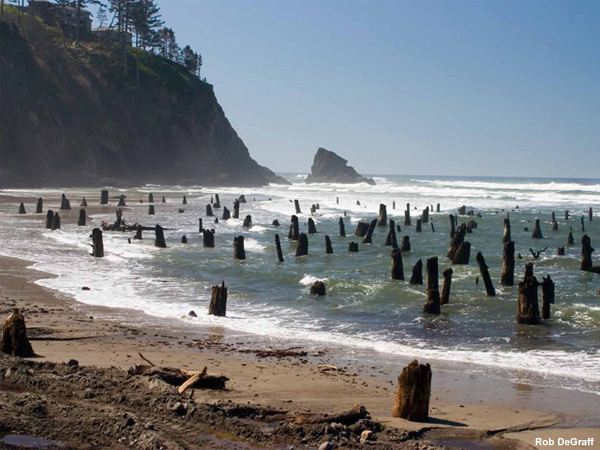
These tree stumps are the remnants of an ancient forest inundated by a catastrophic earthquake or tsunami. Sometimes they are covered, but other times winter storms scour the beach and carry away sand, revealing the "ghost forest".
An earthquake can move land quickly. A tsunami can then inundate it. Scientists wondered: could that have plunged the trees into the water? A tectonic plate boundary—or place where two of earth’s plates meet—lay just off the coast of Oregon and Washington.
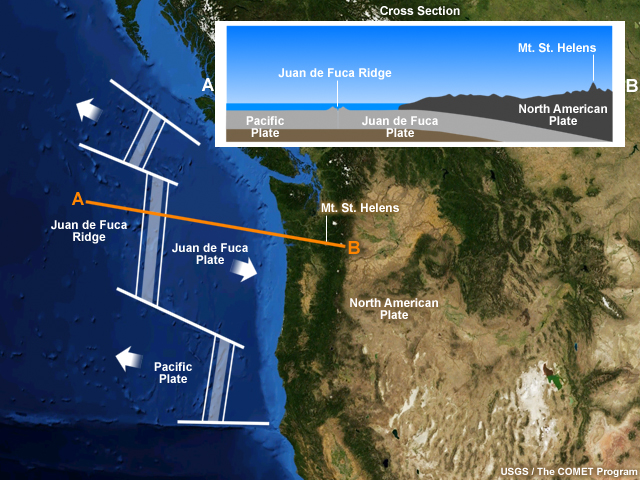
A plate tectonics map of the Pacific Northwest.
The oceanic Juan de Fuca plate, which slides under the North American plate that makes up the coast, seemed like it could rupture where it met the North American Plate. Junctions just like these often generate tsunami-forming earthquakes.
But this fault had not produced a great earthquake in the 250 years since Europeans arrived. Most people thought it wasn't capable of making gigantic earthquakes. Yet there were hints in the legends of native people.
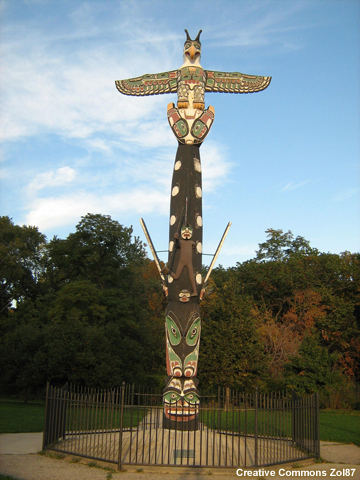
Thunderbird clutches Whale by the tail. A man is riding Whale's back, and a sea monster lurks below.
A medicine man of the Hoh Tribe of western Washington told of a terrible battle between a giant Thunderbird and a titanic whale who was greedily killing other whales. These whales provided the oil that the people needed to “drink and dip their bread and dried berries in,” and soon the people were in danger of starving. Thunderbird saw the people suffering and wanted to help them, so she seized the whale with her sharp talons. After many battles Thunderbird succeeded in killing the whale and its son. The father of the medicine man who told the story said that following its death, “there was also a shaking, jumping up and trembling of the earth beneath, and a rolling up of the great waters.”
The Clayoquot of west Vancouver Island told another story that seems to refer to a tsunami. In the story, the sea suddenly retreated from shore for four days. Most people shrugged off the occurrence, but one man considered it and decided that such an event would likely be followed by a flood. He collected the inner bark of cedar and made a rope. He tied one end to some bushes known for their toughness, and the other end to his canoe. He put his wife, brothers, and sisters-in-law in the canoe. After four days, the tide began to rise, slowly at first, and then it surged inland. When this happened, the rest of his tribe rushed to their canoes and begged to be attached to his rope, but he refused for fear the rope would break. Though this man rode the wave out safely, the rest of his tribe drifted in their canoes far away.
Finally, there is this story about the “Pachena Bay” people. A chief told a story of a tribe of over 100 people living on the beach on Vancouver Island. At night, the land shook, and the people had no time to save themselves. A big wave smashed into the beach and the people were lost, and no one ever found out what became of them.
Scientists started to suspect the ghost forests and the legends and stories might be connected. In the early 1980s, scientists started looking for clues that would help them tell if a great earthquake and tsunami had ever really struck Cascadia. They started by looking at the ways that gigantic earthquakes had affected Alaska and Chile in the early 1960s.
In these great earthquakes, part of the plate on the seafloor thrusts both itself and the water above it up, creating a tsunami. But parts of the plate more inland often drop a few feet as hundreds’ of years worth of strain is finally released. The ocean can inundate land in these places.
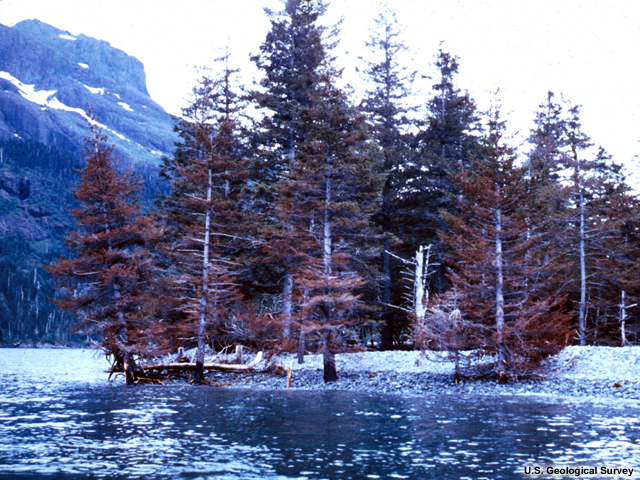
During the Alaska Earthquake on March 27, 1964, these spruce trees subsided 3 feet or ~1 meter. The subsidence dropped their shallow roots below high tide, where they were killed by salt water.
After the Good Friday Earthquake of 1964 in Alaska, the coast dropped about five feet (1.5 m), taking marshes and forest down with it and inundating dry land. Since most tree roots can’t breathe if they are covered in water, the trees died. The ghost forests of Cascadia provided visible proof that the same thing must have happened there.
Scientists could see other earthquake evidence, too. The sudden drop also preserved tidal marsh grass and fallen leaves under the silt because the sudden submersion didn’t give them time to rot. Scientists even found the remains of fire pits and weavings made by people who used the land before it dropped below the ocean. Some of these people may be the very ones the legends spoke of.
But had a tsunami followed the earthquake? As tsunamis wash inland they often leave veneers of sand that are later covered by silt deposited by tides. These “sand sheets” were found on shore up and down the Cascadia subduction zone.
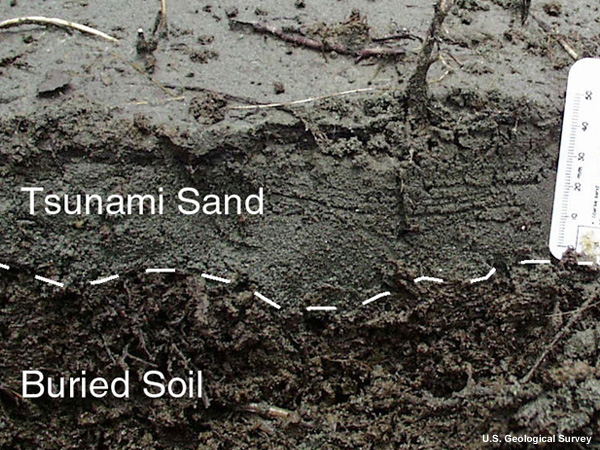
Tsunami deposits of sand over soil in Papua New Guinea after the 1998 tsunami.
When did it happen? Scientists could use special forms of radioactive carbon in the trees and buried marsh grass and leaves to estimate it happened between 1695 and 1720. That seemed to be as close as they could get until someone had an idea: though written records were not kept in northwest America at that time, they were kept in Japan. What if the tsunami waves traveled all the way across the Pacific and were recorded there?
Sure enough, Japanese researchers had known for some time of an “orphan tsunami,” or tsunami that was not preceded by a local earthquake, that struck Japan in 1700. At that time, samurai, merchants, and even peasant village headmen all knew how to read and write. The records they left behind spoke of waves from the ocean that arrived without warning, rising a few meters and sweeping away houses, starting fires, destroying crops, sinking a ship, and flooding a government storehouse. One village headman wondered what to call unusual waves that came without an earthquake. He asked, but no one in his village had ever experienced such a thing. It would be 300 years before the source of the puzzling waves was discovered.
Japan
Japan is surrounded by faults and oceans—which makes it a perennial target for tsunamis. Tens of thousands of Japanese have died as eight major tsunamis hit the coasts in the past 160 years. The Japanese have a story called the “Fire of Rice Sheaves” that they teach to schoolchildren as a model of good behavior and a reminder to seek high ground after earthquakes:
Once there was a rice farmer named Gohei who lived on a farm on high ground near a village by the sea. One day, the villagers were busily preparing for a harvest festival. Gohei was at home when he suddenly felt the earth shake. It was a long, slow shaking that produced noises nothing like Gohei had ever experienced. He went out of his house and looked down on the village from his garden. The people were so busy preparing for their festival that few realized an earthquake had even happened.
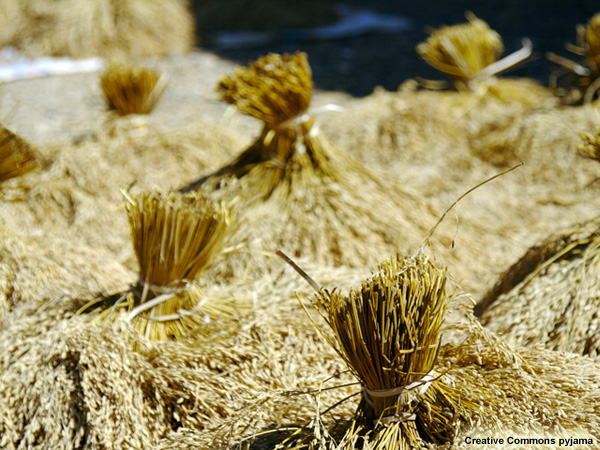
Sheaves of rice at harvest time.
Gohei then looked up and gazed at the sea, and he saw an alarming sight: the ocean had withdrawn from the beach, revealing broad sand flats and beds of rock. Gohei knew what that meant: a tsunami was coming. Four hundred people milled about below, unaware of their danger. And there was little time, he knew, before the first wave would arrive. He ran into his house and fetched a torch. Outside in the fields were sheaves of rice from his farm: cut stalks of grain tied together in bundles. He thought about the loss of the rice he’d worked so hard for, but he knew all the lives he could save would be worth much more. He touched his torch from one sheaf to another, and soon the field was alight.
When he finished, he looked out at the ocean and village. The sun was setting, and in the growing darkness someone below noticed the blaze on the hill. The alarm bell in the temple clanged. The entire village—young, old, women, and children—began climbing up the mountainside. Gohei felt they were crawling up the mountain it took them so long, but eventually all the village arrived. The young men who were first to arrive began to put out the flames, but Gohei shouted for them to let the rice burn. When all villagers had arrived and been counted, Gohei called for them to look out to sea. In the dusky light they saw a dark line on the horizon. It grew taller and broader as it neared the coast. The villagers suddenly understood the meaning of the burning sheaves.
The water struck with “the weight of a mountain and the roar of hundreds of thunderbolts.” Ocean spray filled the air. The sea retreated and advanced two or three more times before it was over. The village had disappeared. All were silent for a time in shock and disbelief. When they realized Gohei had saved their lives, they turned and knelt before him in thanks.
This legend is based on a true story, like many legends. The town of Hiro-mura, Japan, was struck by two earthquakes on Dec. 24, 1854. After the first earthquake people evacuated but no tsunami came. After the second even stronger quake, the people made another run for it but were not fast enough, and many were caught in the wave. Rice farmer and soy sauce maker Hamaguchi Goryou knew that other waves might come. Many others knew this too but were wandering lost in the darkness. Hamaguchi decided to burn his own rice sheaves to guide people to safety. The second tsunami was even bigger than the first, advancing so far that it even put out the burning rice. But thanks to Hamaguchi’s efforts, only 36 of the town’s 1,300 residents died.
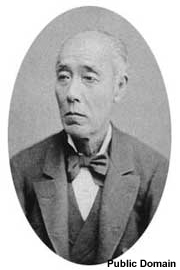
Hamaguchi Goryou
The Mediterranean
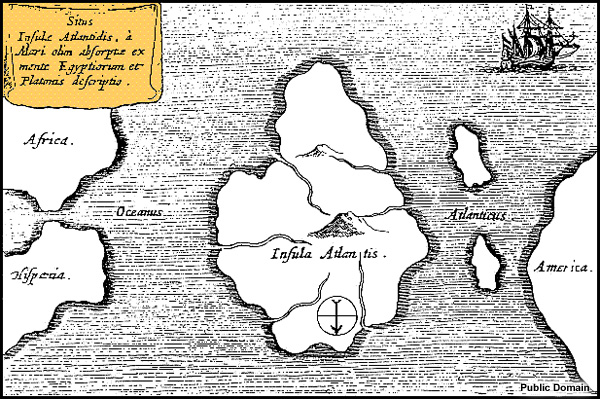
An imagined map of Atlantis.
The philosopher Plato told a story about a mighty continent called Atlantis off the coast of Europe, which was inhabited by a people descended from the god Poseidon. They were ruled by a confederation of kings, who dwelt in a splendid palace ringed by three walls and three moats. According to Plato, 9,000 years before his time the Atlanteans invaded Europe with the intention of conquering it and continuing on to Asia. They succeeded in winning parts of Libya and Africa as far as Egypt and Europe as far as what would later become Rome, taking prisoners of war as slaves. The Athenians, inhabitants of a great city in Greece called Athens, defeated the Atlanteans and freed the lands they’d conquered. More bad news was in store for Atlantis. Plato wrote that earthquakes and floods in one day and night caused the sea to swallow the island. All that was left were muddy shoals that made the ocean impassable where the island had been.
Many modern scholars believe this legend was based on a disaster that befell the ancient Mediterranean island of Crete, home of Europe’s first civilization, the Minoans. The Minoans were traders and sailors who painted their walls with scenes of daily life and elaborate bull-jumping contests.
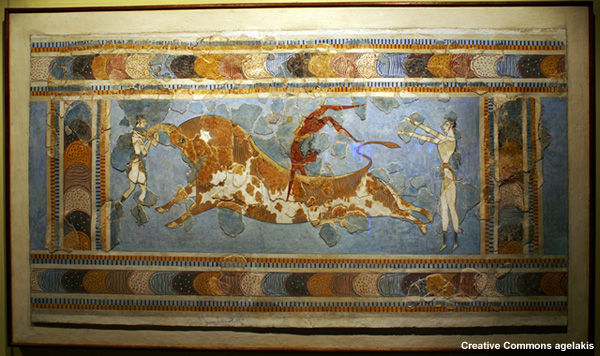
A Cretan fresco (wall painting) of bull jumping.
In the 1500-1600s BC, the volcano Thera on the island of Santorini in the Aegean Sea exploded, and most of the volcano’s cone collapsed into the sea, leaving a ring of land. It must have made a tremendous tsunami.
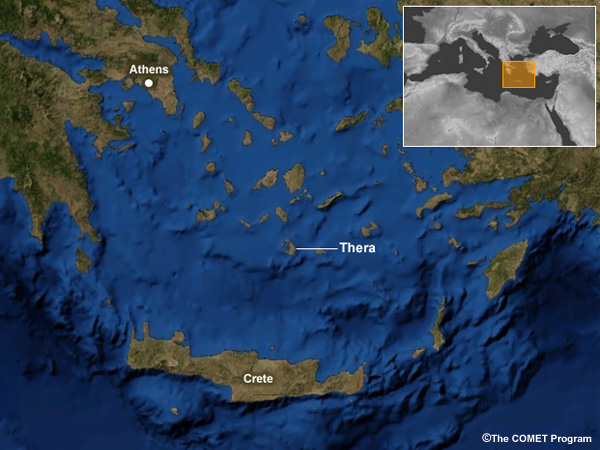
A map of the volcano Thera on the Greek Island of Santorini. Mainland Greece is at the upper left, and Turkey is on the right.
On Crete, scientists have found bits of Minoan buildings, pottery, cups, and food remains like animal bones jumbled together with beach pebbles, sea shells, and marine microbes. These mixtures were found 21 feet above sea level, seeming to eliminate the possibility of a ferocious storm. In other cases, buildings near the sea were missing only the seaward wall. Scientists who have dated the jumble of terrestrial and oceanic deposits have found they are about the same age as the eruption of Thera. Could Crete, then, be Plato’s mighty ancient civilization that died beneath the waves?
Australia
Though Australia and New Zealand don’t have a history of great earthquakes, massive tsunamis may have hit their coasts several times after comets struck or exploded over nearby ocean. Some scientists believe there is an impact crater called Mahuika in the ocean south of New Zealand and other good evidence for an impact around 1500 AD. Others disagree. Whatever happened, the legends are compelling.
A tribe from New South Wales, the Paakantji, have a legend of a thundering ball of fire that fell from the sky and scattered many-colored molten rocks. Floods followed that caused the people to flee to mountaintops. A coastal tribe has a legend about “the moon setting in the east” followed by flooding of rivers without storms. Another tribe talks of a spear falling from the sky into the sea and then a coast-altering flood. In some legends, the Glasshouse Mountains in southeast Queensland were said to be the frozen forms of a man called Tibrogargan and his family. Tibrogargan saw the ocean swell one day. Worried, he fled inland with his family. Some of the peaks of the Glasshouse Range are said to represent the family, still looking towards the ocean in alarm.
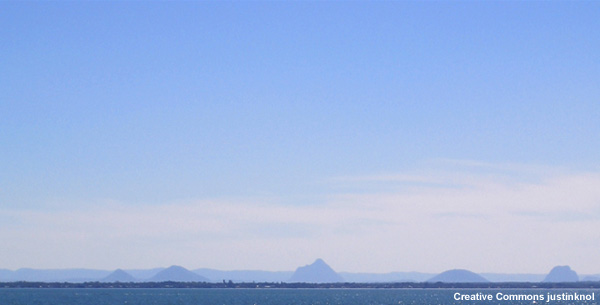
Australia's Glasshouse Mountains as they appear from the sea.
Finally, legends from Australia's northwest coast of a massive tsunami also hint at a different impact there. The first European explorers to reach western tribes noticed the Aborigines shunned the coast and didn't use it for food, even though there was evidence they had enjoyed eating shellfish there in the past. In one story, a "star with trails" caused a flood. Mythical beings called the "Wandjina," whose depictions may be meant to resemble a comet, also caused a great flood that began in the north and filled the whole country. As quickly as the land flooded, it drained.
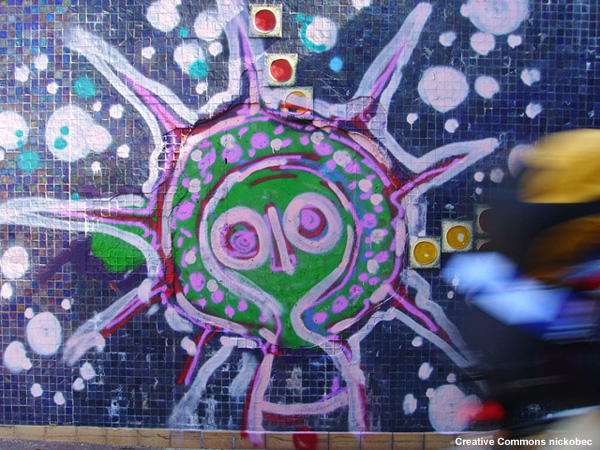
Street art of an Australian Aborigine mythical being called a wandjina that may represent a comet.
Southeast Asia
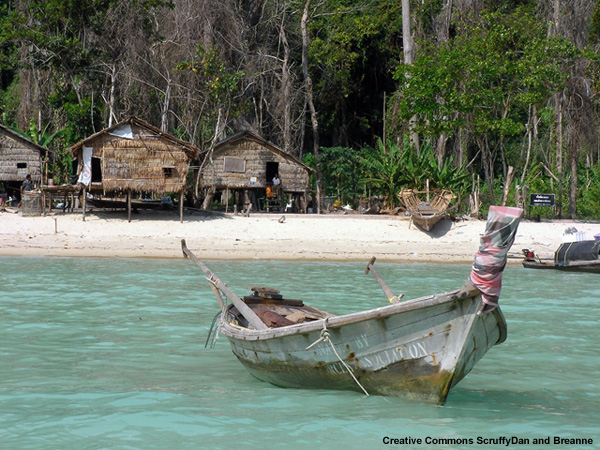
A Moken, or sea gypsy, boat and village in Thailand.
In the tsunami of Dec. 26, 2004, hundreds of thousands of people living on the shores of the Indian Ocean died. But on a few scattered islands off the coasts of Myanmar and Thailand, almost no one died. These tribes had tsunami legends that nearly every member had heard many times. When they felt the earth shake, they knew exactly what to do.
The Moken, “sea gypsies” of the Surin Islands off the coast of Thailand, believe that monster waves are made by Katoy Oken, the spirit of the sea. He sends them to purify the people physically and spiritually. One of their legends says that hundreds of years ago, the people felt the earth shake while coconuts dropped from trees. They hastily gathered the dropped nuts then climbed into a boat and pushed it out to sea. After paddling out to sea for about 30 minutes, they felt a small disturbance under the boat. One of the elders waved to everyone to look back towards the beach. The water had retreated. Soon a huge wave, tall as the coconut trees, hit the shore and swallowed the island. But the people survived.
In 2004, the Moken saw the sea retreating from their island and remembered the legend. They ran toward the highest ground they could find, this time not even pausing to collect coconuts. More than 200 people lived on the island, but only one died: a disabled man accidentally left behind during the confused evacuation. But a nearby tribe of sea gypsies living on the mainland, the Moklen, had forgotten their legends as they integrated into Thai society. A village shaman said he knew something was amiss when he saw the water sucked out to sea but had no idea what it might be. The women and children didn’t flee; they headed to the beach to pick up fish and crabs. More than 20 tribe members died.
Alaska
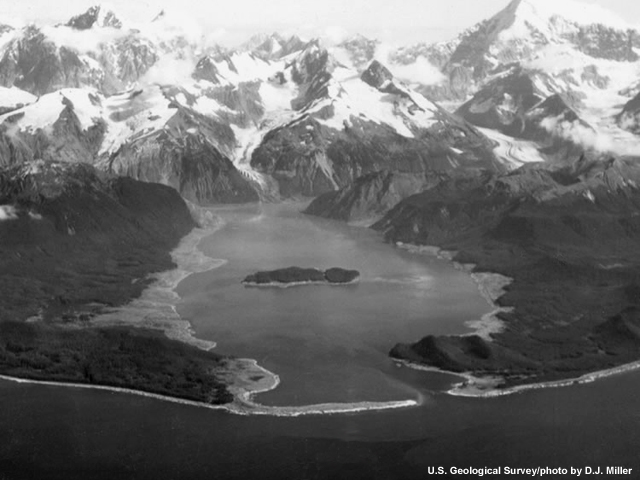
A view of Lituya Bay, Alaska, and the bathtub ring of missing trees caused by a giant tsunami produced by a landslide.
Lituya Bay, Alaska, is the site of the world’s tallest recorded wave. On July 9, 1958, an earthquake of magnitude 7.9 struck near the bay, the strongest in 50 years. A huge section of a mountain broke off and the rocks fell in to Lituya Bay, where they made a wave that traveled 1,720 feet up the hill opposite the fall. This was not the first time such waves had scoured the bay. Scientists estimate at least five other waves occurred in the last 150 years. The native people told a legend to explain these waves:
“And so the legend of Lituya tells of a monster of the deep who dwells in the ocean caverns near the entrance. He is known as Kah Lituya, ‘the man of Lituya.’ He resents any approach to his domain, and all of those whom he destroys become his slaves, and take the form of bears, and from their watch towers on the lofty mountains of the Mt. Fairweather range they herald the approach of canoes, and with their master they grasp the surface water and shake it as if it were a sheet, causing the tidal waves to rise and engulf the unwary.”
From Emmons, G.T. (1911) “Native account of the meeting between La Perouse and the Tlingit.” American Anthropologist, New Series, Vol. 13, No. 2. (Apr. - Jun., 1911), pp. 294-298.
Click here to return to the 6+ Hours Page.